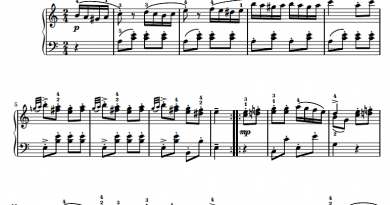Minor scales on the piano – Music Keys
Minor scales are diatonic scales with a mediant at a minor third above the tonic note. The most used minor scales in western classical, jazz and contemporary music are the harmonic minor, melodic and natural minor scale.
Playing minor scales on piano : fingering
Here are the 12 minor scales with their fingering on piano:
- A minor scale
- B flat minor scales
- B minor key
- C minor scales
- C sharp min key
- D minor scale on piano
- Eb or D sharp min scales
- E minor
- F minor scale
- F# min keys
- G minor scales
- A flat or G sharp minor
Minor scales : theory : types
Here are the main types of minor scale used in western music. For example, the well known masterpiece Fur Elise piano is in this key. The first one is the Natural minor scale and is the relative major scale starting from its 6th degree. (In this figure it is C major starting from A, that is its sixth degree).

In this figure, instead, you can see the harmonic minor scale which has the seventh degree raised by an half step.

The ascending melodic minor scale has the sixth and seventh degree raised.

However, melodic minor scale has no alteration when it descends as shown by this figure.

Neither the C major nor the A minor scale have any sharps or flats. The A minor consists of the following tones:

When examine these intervals we find

The major scale is constructed thus:

There are, therefore, differences between 2 and 3; 3 and 4; 5 and 6; 7 and 8. When playing the minor scale as written on the previous page it sounds somewhat harsh and unpleasant to the ear. order to make it more pleasing some authors have written it thus :

When examining this scale it is found to be exactly like the major scale, with this difference, that the half step lies between 2 and 3, instead of between 3 and 4. This scale is called the melodic minor scale, because it is melodious and pleasant. There is, however, another minor scale and it is written in this wise:

This scale is necessary for us in order to build chords, and for this reason it is called the harmonic minor scale. It differs from the above melodic in so far that it has a half-step from 5 6 and a step and a half from 6 7. Thus it will be seen that we have three minor scales. While they differ in the last three notes, they all agree in having a half-step from 2 3. We may, therefore, say that the characteristic difference between the major and minor scale is this, that the major has a large third a whole step from 2 3, while the minor has a small third or a half step from 2 3. Though these scales differ in their construction, they are all alike good and a writer may use whichever he choses. Though they differ in the ascending scale they usually agree in their mode of descending. The following is the style in which all A minor scales descend :

Instances, however, are known where writers ascended with the melodic scale and descended with the harmonic Relative Major and Minor Scales. Each major has a relative minor scale, which is found three half steps below the keynote of the major scale. The relative major and minor scales have the same number of sharps or flats, as will be seen from the following schedule:

Observe, we start from C and go upwards by fifths until we come to F#, when we change to Gb which on the piano is the same key, and continuing thus by fifths we return to C. in alike manner we begin with A minor and move upwards by fifths until we reach D# when we change to Eb which is the same key on the piano, and from this tone we move on until we return to A. This is called the fifth circle or the circle of fifths. Each fifth we moved to had an additional sharp, so from Gb every fifth tone had a flat less. Starting out from A, by moving on fifth every new fifths give us and additional sharp, so every additional fifth from Eb on to A has a flat less.


